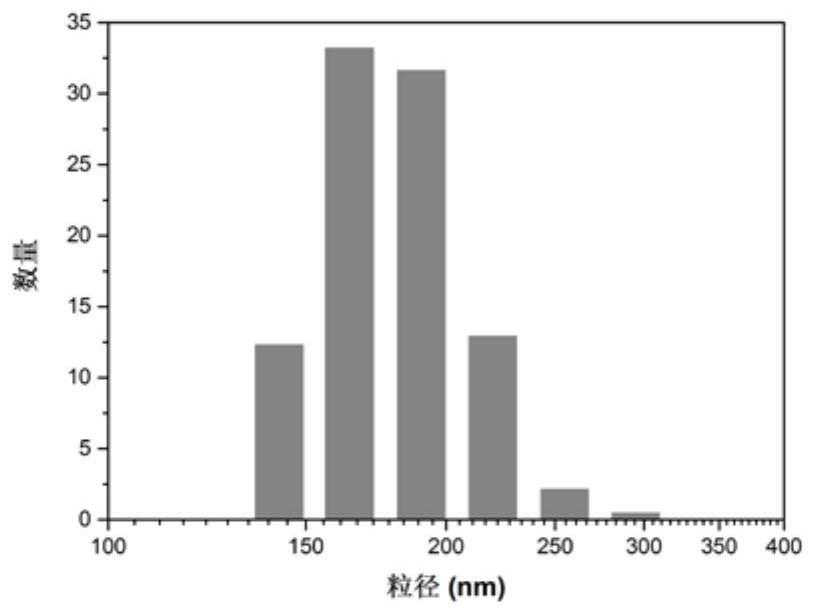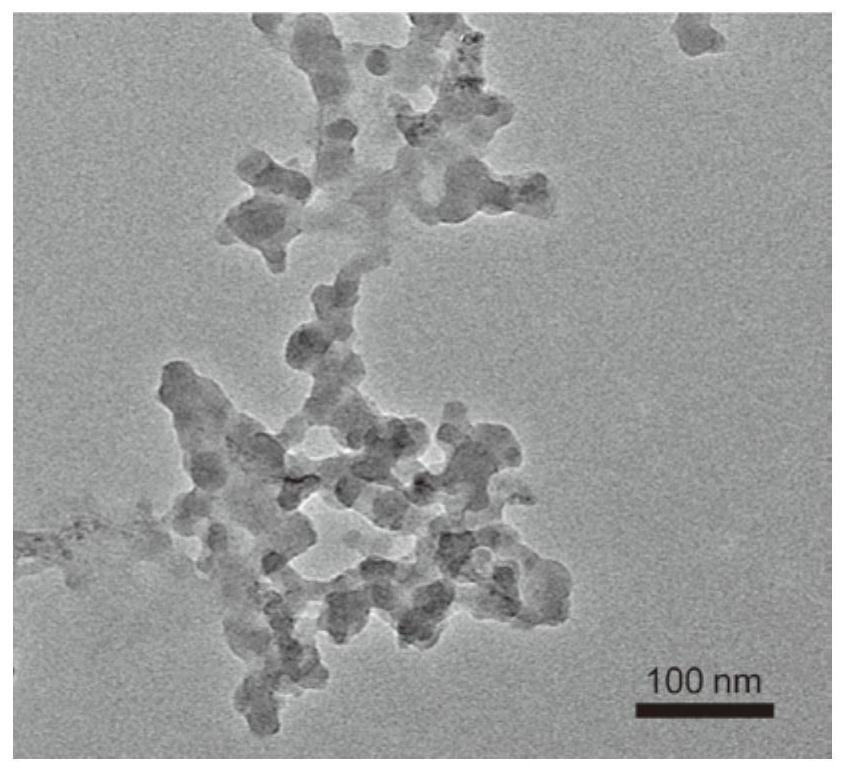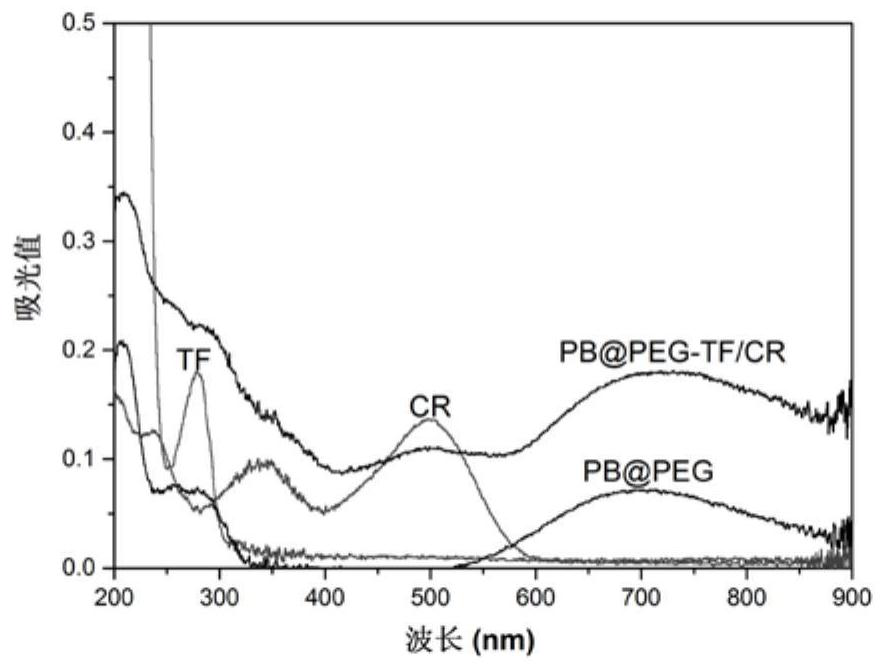A kind of Prussian blue nanoparticle targeting Aβ senile plaque and preparation method thereof
A technology of Prussian blue and nanoparticles, which is applied in the field of biomedicine, can solve the problem that Prussian blue nanoparticles are difficult to target and modify, and achieve good biocompatibility and biosafety, simple operation, and good stability.
- Summary
- Abstract
- Description
- Claims
- Application Information
AI Technical Summary
Problems solved by technology
Method used
Image
Examples
Embodiment 1
[0030] 1) Dissolve 0.01 mmol of potassium ferrocyanide and 0.001 mmol of mPEG-COOH in 5 ml of deionized water, and mix thoroughly to obtain a clear solution A; dissolve 0.01 mmol of ferric chloride in 5 ml of deionized water, Fully dissolve to obtain a clear solution B; add solution B dropwise to solution A, and react at 60°C for 0.5h;
[0031] 2) Wait until the reaction system is lowered to room temperature, react for 0.5 h, and centrifuge to wash to obtain a precipitate C of Prussian blue nanoparticles modified with polyethylene glycol containing carboxyl groups;
[0032] 3) Precipitate C, 0.1 mmol of 1-(3-dimethylaminopropyl)-3-ethylcarbodiimide hydrochloride were dissolved in 10 ml of carboxyl-containing polyethylene glycol-modified Prussian blue nanoparticles In deionized water, react at room temperature for 15 minutes to obtain solution D;
[0033] 4) Add 0.1 mmol N-hydroxysuccinimide, 0.01 mg transferrin, and 0.4 micromol Congo red to solution D, react at room temperat...
Embodiment 2
[0036] 1) Dissolve 0.005 mmol of potassium ferrocyanide and 0.005 mmol of mPEG-COOH in 5 ml of deionized water respectively, and mix well to obtain a clear solution A; dissolve 0.005 mmol of ferric chloride in 5 ml of deionized water, Fully dissolve to obtain a clear solution B; add solution B dropwise to solution A, and react at 55°C for 0.5h;
[0037] 2) After the reaction system is lowered to room temperature, react for 1 hour, and centrifuge to wash to obtain a precipitate C of Prussian blue nanoparticles modified with polyethylene glycol containing carboxyl groups;
[0038] 3) Precipitate C, 0.05 mmol of 1-(3-dimethylaminopropyl)-3-ethylcarbodiimide hydrochloride were dissolved in 10 ml of carboxyl-containing polyethylene glycol-modified Prussian blue nanoparticles In deionized water, react at room temperature for 10 minutes to obtain solution D;
[0039] 4) Add 0.04 mmol N-hydroxysuccinimide, 0.005 mg transferrin, and 0.48 micromol Congo red to solution D, react at room...
Embodiment 3
[0042] 1) Dissolve 0.0195 mmol of potassium ferrocyanide and 0.003 mmol of COOH-PEG-COOH in 5 ml of deionized water, and mix well to obtain clear solution A; dissolve 0.0195 mmol of ferric chloride in 5 ml of deionized water Fully dissolve in water to obtain a clear solution B; add solution B dropwise to solution A, and react at 60°C for 1 hour;
[0043] 2) Wait until the reaction system is lowered to room temperature, react for 0.5 h, and centrifuge to wash to obtain a precipitate C of Prussian blue nanoparticles modified with polyethylene glycol containing carboxyl groups;
[0044] 3) Precipitation C and 0.12 mmol of 1-(3-dimethylaminopropyl)-3-ethylcarbodiimide hydrochloride were dissolved in 10 ml of carboxyl-containing polyethylene glycol-modified Prussian blue nanoparticles In deionized water, react at room temperature for 25 minutes to obtain solution D;
[0045] 4) Add 0.02 mmol of N-hydroxysuccinimide, 0.02 mg of transferrin, and 0.6 micromol of Congo red to solution...
PUM
| Property | Measurement | Unit |
|---|---|---|
| particle diameter | aaaaa | aaaaa |
| particle diameter | aaaaa | aaaaa |
| particle diameter | aaaaa | aaaaa |
Abstract
Description
Claims
Application Information
 Login to View More
Login to View More - R&D
- Intellectual Property
- Life Sciences
- Materials
- Tech Scout
- Unparalleled Data Quality
- Higher Quality Content
- 60% Fewer Hallucinations
Browse by: Latest US Patents, China's latest patents, Technical Efficacy Thesaurus, Application Domain, Technology Topic, Popular Technical Reports.
© 2025 PatSnap. All rights reserved.Legal|Privacy policy|Modern Slavery Act Transparency Statement|Sitemap|About US| Contact US: help@patsnap.com



